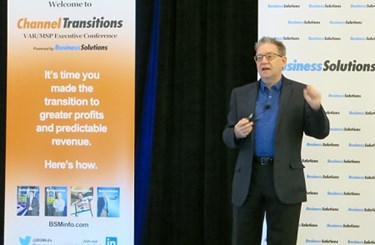Managed Services Tiers, Pricing Questions Answered At Channel Transitions


New managed services providers (MSPs) — and even some seasoned MSPs — have questions on bundling and pricing services and whether to offer discounts and package tiers. Karl Palachuk, keynote speaker at Channel Transitions VAR/MSP Executive Conference, powered by Business Solutions on Sept. 24 at the DoubleTree Chicago-Downers Grove, had answers.
Palachuk is the owner of Small Biz Thoughts and author of 15 books, including Managed Services in a Month and the four-volume Managed Services Operations Manual. He is a former executive at a point of sale (POS) and inventory management company and has global experience as a writer, blogger, speaker, and IT business consultant. He invited questions from conference attendees at the end of his presentation.
Audience Question #1: “We are experimenting with offering three tiers of service packages. We don’t tell clients what the itemized parts are. Should we exclude prices from the à la carte list on the price sheet?”
Palachuk responded that he doesn’t recommend offering services à la carte, and instead suggested focusing on the development of tiered packages. The “platinum” bundle should include everything your client will need such as antivirus, spam filter, storage, backup, email, and network security. He also stressed that your platinum package should include what differentiates you — what you excel at — whether it’s voice, signage, wireless networks, etc.
Palachuk said to also develop gold and silver tiers of service packages, although, he said he has never sold a “gold” package; customers look at the options and choose the best one. Palachuk commented, “People don’t like to be sold, but they like to go shopping. Let them go shopping and choose platinum.”
Audience Question #2: “How do you price the three levels?”
Palachuk said one method that could help set prices when you first transition from the break-fix business model to managed services is to review what each client paid you last year and how much time and labor it took to provide services to them. This can become the basis for a managed services package price in line with what you charged them the previous year.
Palachuk pointed out, however, “We are paying less and less for cloud services each year. We’re at the point where you start by doubling the price and go up from there.”
He gave an example of a bundle that includes all the technology to support five people at an MSP’s client’s business. The bundle costs the MSP about $75 per month. The MSP priced it at $249 per month, and Palachuk added that because the business has more than five employees, he would suggest selling another “five pack,” rather than trying to break it down to support another two or three people. Palachuk said managed services costs another $249 per month to support five users, and, again, add an additional $249 because the business has between five and 10 employees. “Now we’re at $1,000 per month,” Palachuk said, “the sweet spot for small clients and managed services.”
As for setting prices based on what competitors charge, Palachuk said, “It’s irrelevant. I don’t look at what they charge except to make sure my price is above theirs.”
“You decide how you want to do business, and then go find people to work within your business model,” he said. This can be providing services to a few customers that each pay $10,000 per month or to larger number of customers who each pay a smaller amount each month — both models, he said, can work well.
Audience Question #3: “Is there an advantage to offering a discount to customers who pay early?”
Palachuk answered, “No. We’re always tempted to give a discount on the most important things we sell. Just don’t.”
During his keynote, Palachuk emphasized that MSPs should always get paid in advance. He shared an example of a car wash in Sacramento that allows customers to pay one fee and wash their cars as many times as they want per month. Palachuk said this “managed car wash” is an example of how people want to pay for things today. You provide everything your client needs each month in a bundle, and they will pay at the beginning of the month to have these managed services. “It’s doing things right,” he said. “You don’t give a discount for doing things right.”
Palachuk pointed out MSPs that do not get paid up front will find themselves “loaning money to their businesses.” When bills are due and they know money is coming in — but isn’t there yet — they cover the bills until they are paid. Unfortunately, this can result in credit card debt (and interest charges) to keep your business operating.
“When you get paid in advance, on the second or third day of the month, all the money you need to take care of your business for the month is there,” Palachuk said. This is in contrast to operating under the break-fix model when you begin each month with zero and try to cover your bills with work that comes in that month. “Getting paid in advance results in a positive cash flow,” commented Palachuk.
For more information on the Channel Transitions VAR/MSP Executive Conference, visit www.ChannelTransitions.comor email Events@BSMinfo.com. Channel Transitions will also be held on November 5 in Orlando, FL.
Channel Transitions is sponsored by platinum sponsors MAXfocus, and Worldpay, gold sponsors Harbortouch and Webroot, and networking sponsors Great America, Mercury, and Moneris, along with industry association partners CompTIA, The ASCII Group, and the Retail Solutions Providers Association (RSPA).
